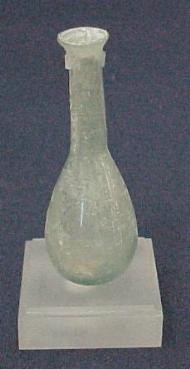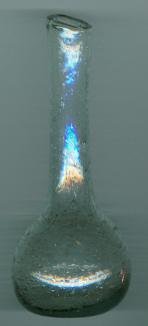
 Antique bottles are the most exciting type of lachrymatory to collect. These beautiful creations
give us a chance to touch history. If you hope to collect these ancient
treasures, use care and have fun. Ancient bottles come from many regions and
many time periods. These factors can be as important as the bottles condition
when estimating value. Antique bottles are the most exciting type of lachrymatory to collect. These beautiful creations
give us a chance to touch history. If you hope to collect these ancient
treasures, use care and have fun. Ancient bottles come from many regions and
many time periods. These factors can be as important as the bottles condition
when estimating value.
Ancient Roman Bottles
The Roman empire produced a large quantity of lachrymatories. Ceramic and
glass bottles are both available and can be found at auctions around the world.
Glass blowing was created around 100 A.D., so you'll find only ceramic vials
(with the possible exception of Chinese carved stone) before then.
Auction guidelines
The classic approach to getting the best deal in antiquities is buying
through auctions. Of course, be sure to use a reputable auction house if you
take this approach. Two of the best known houses are
Sotheby's and
Christie's. If you are
looking for a more grass-roots approach,
ebay is the popular approach.
Remember, buyer beware. There may be a great selection at
ebay, but make sure you
understand what you are buying before you bid.
 |
This beautiful bottle, made in the
style and glass of ancient Egypt, is actually a contemporary reproduction.
|
Words of Caution
Nearly as soon as the original bottles were found, fake or counterfeit
bottles have been produced. If you are interested in antiques, be sure to buy from a reputable vendor or auction house.
Also be sure to insure
the authenticity and provenance of your acquisition.
The best deals on antiques can be found in the country of origin. But, most
countries have strict export restrictions on many historic items. Be sure to
investigate local laws and restrictions before purchasing anything. A reputable
antique house can provide assistance in safely exporting your new purchase.
If you learn of any other artists or manufacturers that should be listed on
these pages, please let me know.
| 
